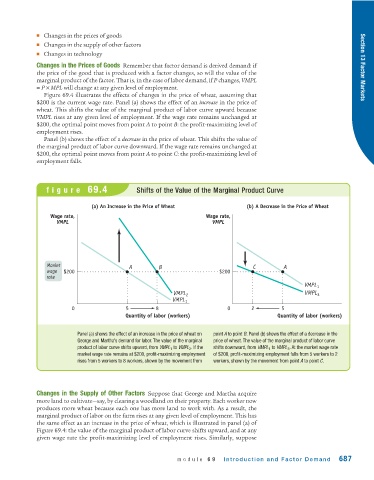Page 729 - Krugmans Economics for AP Text Book_Neat
P. 729
■ Changes in the prices of goods
■ Changes in the supply of other factors
■ Changes in technology
Changes in the Prices of Goods Remember that factor demand is derived demand: if Section 13 Factor Markets
the price of the good that is produced with a factor changes, so will the value of the
marginal product of the factor. That is, in the case of labor demand, if P changes, VMPL
= P × MPL will change at any given level of employment.
Figure 69.4 illustrates the effects of changes in the price of wheat, assuming that
$200 is the current wage rate. Panel (a) shows the effect of an increase in the price of
wheat. This shifts the value of the marginal product of labor curve upward because
VMPL rises at any given level of employment. If the wage rate remains unchanged at
$200, the optimal point moves from point A to point B: the profit-maximizing level of
employment rises.
Panel (b) shows the effect of a decrease in the price of wheat. This shifts the value of
the marginal product of labor curve downward. If the wage rate remains unchanged at
$200, the optimal point moves from point A to point C: the profit-maximizing level of
employment falls.
figure 69.4 Shifts of the Value of the Marginal Product Curve
(a) An Increase in the Price of Wheat (b) A Decrease in the Price of Wheat
Wage rate, Wage rate,
VMPL VMPL
Market A B C A
wage $200 $200
rate
VMPL 1
VMPL 2 VMPL 3
VMPL 1
0 5 8 0 2 5
Quantity of labor (workers) Quantity of labor (workers)
Panel (a) shows the effect of an increase in the price of wheat on point A to point B. Panel (b) shows the effect of a decrease in the
George and Martha’s demand for labor. The value of the marginal price of wheat. The value of the marginal product of labor curve
product of labor curve shifts upward, from VMPL 1 to VMPL 2 . If the shifts downward, from VMPL 1 to VMPL 3 . At the market wage rate
market wage rate remains at $200, profit-maximizing employment of $200, profit-maximizing employment falls from 5 workers to 2
rises from 5 workers to 8 workers, shown by the movement from workers, shown by the movement from point A to point C.
Changes in the Supply of Other Factors Suppose that George and Martha acquire
more land to cultivate—say, by clearing a woodland on their property. Each worker now
produces more wheat because each one has more land to work with. As a result, the
marginal product of labor on the farm rises at any given level of employment. This has
the same effect as an increase in the price of wheat, which is illustrated in panel (a) of
Figure 69.4: the value of the marginal product of labor curve shifts upward, and at any
given wage rate the profit-maximizing level of employment rises. Similarly, suppose
module 69 Introduction and Factor Demand 687

